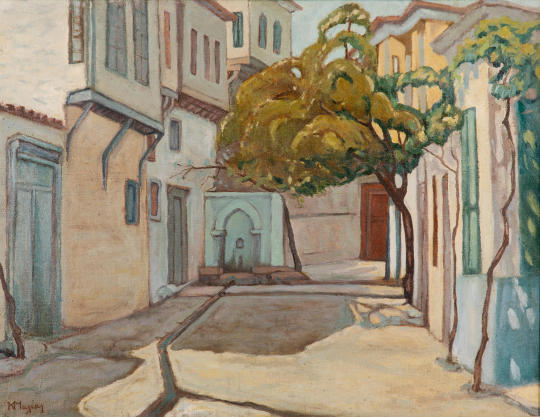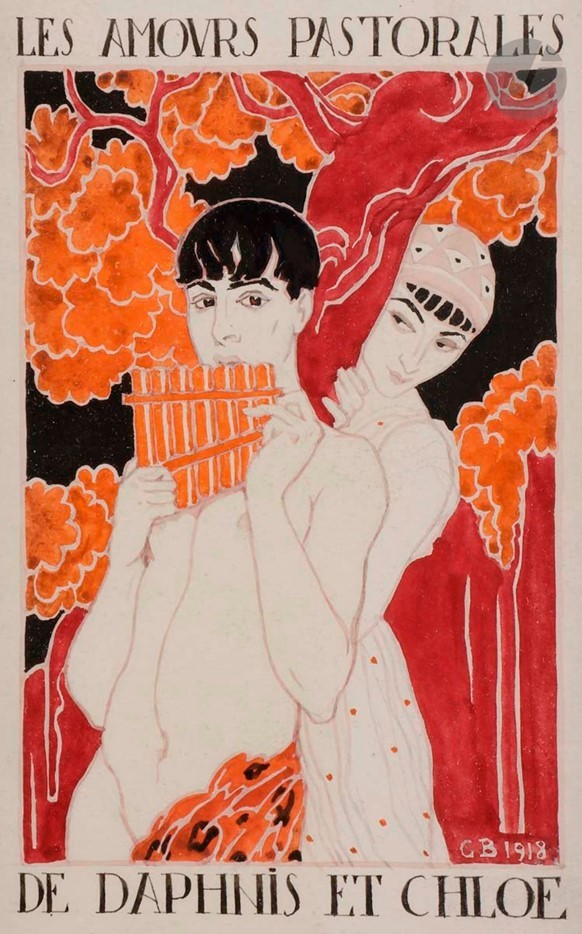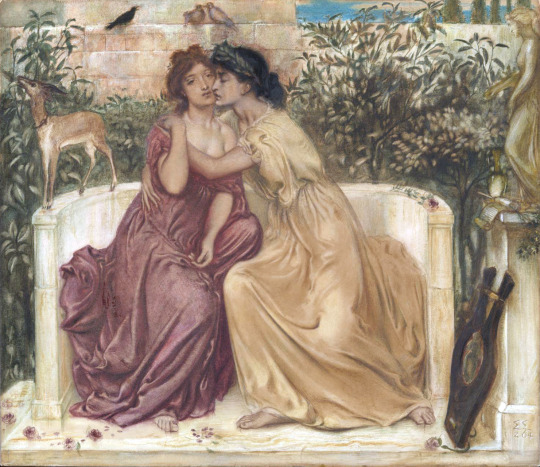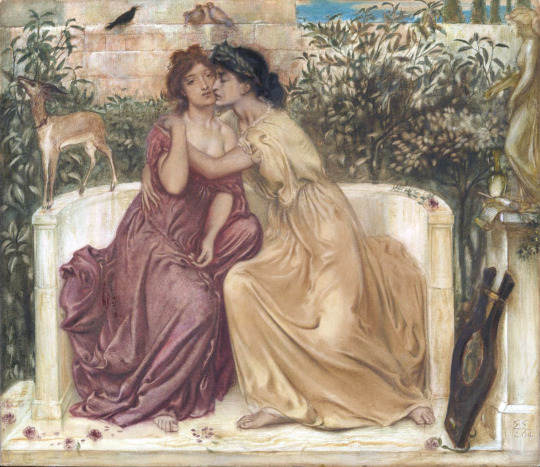#Mytilene
Explore tagged Tumblr posts
Text

Constantinos Maleas (Greek, 1879-1928), Back Street in Mytilene, c.1921-23. Oil on canvas, 53.5 x 70 cm.
#constantinos maleas#konstantinos maleas#Κωνσταντίνος Μαλέας#greek art#street scene#back street#mytilene#trees
188 notes
·
View notes
Text

George Barbier, Les Amours pastorales de Daphnis et Chloé, 1918.
The subject of Daphnis and Chloe is distinguished from other Greek novels by its bucolic setting and the constant irony which governs the course of the action.
It is above all their sentimental education which is described throughout the adventures of the novel. The two protagonists live in the countryside, near the city of Mytilene on the islandof Lesbos. Daphnis is a young goatherd, a child found by shepherds (in a laurel grove, hence his name which comes from the ancient Greek δάφνη (daphnè), laurel). Chloé, for her part, is a shepherdess, also a foundling. They grow up in a pastoral setting and fall in love with each other, but multiple twists and turns prevent them from satisfying their love. However, the outcome is a comedy: the two children are recognized by their respective parents, who are rich people from Mytilene, lifelong friends, and who are going to marry them. (x)
#george barbier#1918#daphnis and chloe#Daphnis et Chloé#barbier#longos#roman de gare#illustration#Ancient Greek#Mytilene#lesvos#lesvos island#1918 illustrations#art#art history#lesbians#ancient#greek#homosexual#lgbtq community#lgbtq
46 notes
·
View notes
Text

METELIN / MYTILENE -> LESBOS ISLAND, GREECE
0 notes
Text

A French official artist at work. Photograph taken at Port Iero, Mitylene.
0 notes
Text

Sappho and Erinna in a Garden at Mytilene (1864)
Simeon Solomon (1840 - 1905)
#sappho and erinna in a garden at mytilene#simeon solomon#wlw#wlw art#wlw aesthetic#wlw romance#wlw love#sapphic#sapphic art#sapphic aesthetic#sapphic romance#sapphic love#sapphics#lgbt#lgbt art#lgbt aesthetic#lgbtq#lgbtqia#lgbtqia+#art#historical art#painting#paintings#historical painting#history#herstory#aesthetic#a e s t h e t i c#1860s#1800s
807 notes
·
View notes
Text
Seeing the world in Tamarian.
One of the gifts, or curses, of being a Star Trek fan, and especially a Lower Decks fan, is that I now frequently see, hear, and read things as though they were phrases in Tamarian (the aliens who's language his composed of communicating through stories/metaphors, for example "Shaka, when the walls fell" refers to a disaster, while "Darmok and Jalad at Tanagra" refers to enemies working together against a common threat).
Originally introduced in Star Trek: The Next Generation's "Darmok", though Lower Decks has really leaned into the idea since. They've sometimes been referred to as the aliens who speak in memes.
So now, I often think of how things would sound or how you might say something or use an event to mean something in Tamarian.
For example, a while back I posted this painting, by 19th/early 20th century gay Jewish painter Simeon Solomon:

(Image from Wikipedia)
The title, Sappho and Erinna in a Garden at Mytilene, immediately struck me as sounding exactly like how one might say "Lesbians" in Tamarian.
Or a post I saw today on Spoutible, which referred to "Putin, bare chested, on his horse" - which I immediately thought sounds like how you'd say "fascist dictator" (or alternately "small dick energy") in Tamarian.
I don't know, I just think its cool, and I'm curious what other phrases folks might have heard that sound like they would work as part of Tamarian metaphor language.
#Star Trek#Lower Decks#The Next Generation#Darmok#Tamarian#Metaphore#Queer#Sappho and Erinna in a Garden at Mytilene#Simeon Solomon
12 notes
·
View notes
Text
Sappho and Erinna in a Garden at Mytilene
Simeon Solomon
1864

#Simeon Solomon#original art#art#artist painter#Sappho and Erinna in a Garden at Mytilene#art work#art style#art colors#ilustration painter#frank murdoff#ooctoopussy#xpuigc#xpuigc bloc
12 notes
·
View notes
Text

More sprites for Project Mytilene!
7 notes
·
View notes
Text
on the one hand im having a great time reading about the peloponnesian war again but on the other hand i am not going to be able to make sparta saying "let's go lesbians" canon in AaSA for a long time because it's a few years into the war and i haven't even laid the groundwork to start it yet
#athens in the bg looking at his tasteful drawing#of mytilene and mithymna making out or whatever#and then being distraught and throwing a fit when he lowers it and sees them fighting#hapo reads greek history#i need to read juicy thucy#the siege of platea also is some looney tunes shit
4 notes
·
View notes
Text
I also don’t remember picking up on the fact that Kleon was sending a messenger to Mytilene and LET ME TELL YOU I NOTICED THAT THIS TIME
#‘kleon’ and ‘Mytilene’ are historically two very terrible words to be in a sentence together#assassin's creed odyssey#ac odyssey
6 notes
·
View notes
Text
The Eternal Wisdom of Sappho
BY KIRSTY STONELL WALKER
According to the Ancient Greek poet Alcaeus of Mytilene, “No man sings like a Lesbian singer.” A very progressive statement for 600 B.C., but he was actually speaking of the magic and beauty of the lyric poets of the island of Lesbos and, more particularly, of his contemporary Sappho. Possibly the most heralded singer-songwriter of pre-Christian times, Sappho is mainly remembered today for her love of the ladies, as so little of her poetry survives. Yet for a woman who literally gave her name to a euphemism for female gayness, she wrote an awful lot of lust poems about men as well and even apparently threw herself off a cliff because a man didn’t love her. All this complication leads me to Sappho’s unexpected heyday, the 19th century, where this magical Greek poet by necessity became all these things and more.
Let’s start with who Sappho was. As someone who lived around six hundred years before Christ, she didn’t leave a lot of personal information, but we know that she wrote lyric poetry that was intended to be sung with accompanying music and that her work was so popular that she was christened the “Tenth Muse.” Much of what we know about Sappho is inferred from her poems, as the earliest biography of her wasn’t written until nearly 800 years after her death. Most of her poetry is now lost, however, with only fragments....
CONTINUE READING
#Alcaeus of Mytilene#greek#poet#poem#Lesbian#saphho#writing#lust#romanic#singer songwriter#ancient greek
3 notes
·
View notes
Text
I need assistance- me and my gf are doing Halloween as Sappho and Errina! However I would love a digital art or paper art redrawing of the classical painting so I can base my costume (we’re making them from scratch) off of something more cohesive! So if you have art skills please redraw the classic painting I’ll link more information here, here, and here

#wlw post#halloween#digital art#ancient greek#Sappho and Erinna#Sappho and Erinna in a Garden at Mytilene Simeon Solomon 1864#wlw#please draw this#I need help#lesbian
2 notes
·
View notes
Text

"Cops are Killers"
Seen in Mytilene, Lesvos
203 notes
·
View notes
Text

Sappho Playing the Lyre
Artist: Léopold Burthe (French, 1823–1860)
Date: 1849
Medium: Oil on canvas
Collection: Musée des Beaux-Arts de Carcassonne, Carcassonne, France
Sappho
Called the Tenth Muse by Plato, Sappho was a prolific poet of ancient Greece. She innovated the form of poetry through her first-person narration (instead of writing from the vantage point of the gods) and by refining the lyric meter. The details of Sappho’s life have been obscured by legend and mythology, and the best source of information is the Suidas, a Greek lexicon compiled in the 10th century.
Sappho was born on Lesbos to a noble family. She lived most of her life in the city of Mytilene, with the exception of her family’s brief exile in Sicily shortly after 600 B.C.E. She married a wealthy man in Mytilene, and they had a daughter names Cleis. Sappho also headed a thiasos, or an academy of unmarried women. As was the custom at the time, wealthy families sent their daughters to live at these schools where they were taught proper social graces, composition, singing, and poetry recitation. Much of Sappho’s poetry was composed in this community, and she used many of her students as subjects.
Perhaps Sappho’s most famous work is her “Ode to Aphrodite”:
Deathless Aphrodite of the spangled mind, child of Zeus, who twists lures, I beg you do not break with hard pains, O lady, my heart
but come here if ever before you caught my voice far off and listening left your father’s golden house and came,
yoking your car. And fine birds brought you, quick sparrows over the black earth whipping their wings down the sky through midair -
they arrive. But you, O blessed one, smiled in your deathless face and asked what (now again) I have suffered and why (now again) I am calling out
and what I want to happen most of all in my crazy heart. Whom should I persuade (now again) to lead you back into her love? Who, O Sappho, is wronging you?
For if she flees, soon she will pursue. If she refuses gifts, rather will she give them. If she does not love, soon she will love even unwilling.
Come to me now: loose me from hard care and all my heart longs to accomplish, accomplish. You be my ally.
(Carson, If Not, Winter, 2–5)
#painting#sappho#ancient greece#mountaintop#lyre#music#literature#poetry#lyric poetry#female figure#leopold burthe#french painter#oil on canvas#fine art#19th century painting#french culture#oil painting#artwork
179 notes
·
View notes
Text























I THOUGHT IT WAS FORBIDDEN FOR A JEDI.
sapphic anidala
attack of the clones (2002) dir. george lucas / sappho fragment / revenge of the sith screenplay / “sappho and erinna in a garden at mytilene” by simeon solomon / concept art for revenge of the sith by iain mccaig / novitiate (2019) dir. margaret betts / revenge of the sith novelization by matthew stover / exiles in sepharad: the jewish millenium in spain by jeffrey gorsky / attack of the clones screenplay / concept art for revenge of the sith by iain mccaig / illustration of carmilla by d.h. frinston / letter from virginia woolf to vita sackville-west / sappho fragment / attack of the clones deleted scene / “once more to see you” by mitski / concept art for revenge of the sith by iain mccaig / stover / letter from vita sackville-west to virginia woolf / stover / revenge of the sith (2005) dir. george lucas
#my manifesto!!!#this took me obscenely long to put together and it’s incoherent to 90% of the population probably#anidala queer reading prevails tho#if u get it u get it#web weaving#star wars#anidala#anakin skywalker#padmé amidala#padme amidala#star wars prequels#attack of the clones#revenge of the sith#wlw anidala#sapphic anidala#lesbian anidala#sapphic#wlw#lesbian#bisexual#webweaving#web weave#sapphic anidala tag
335 notes
·
View notes
Text
when people post this painting of sappho i wonder if they know that the artist was a gay victorian jewish man who was arrested for buggery in a public urinal

btw it's Sappho and Erinna in a Garden at Mytilene (1864) by Simeon Solomon, currently housed at the Tate and not on display
#academia was a trudge thro hell#but at least it gave me an excuse to hyperfixate on simeon solomon#what a guy
1K notes
·
View notes